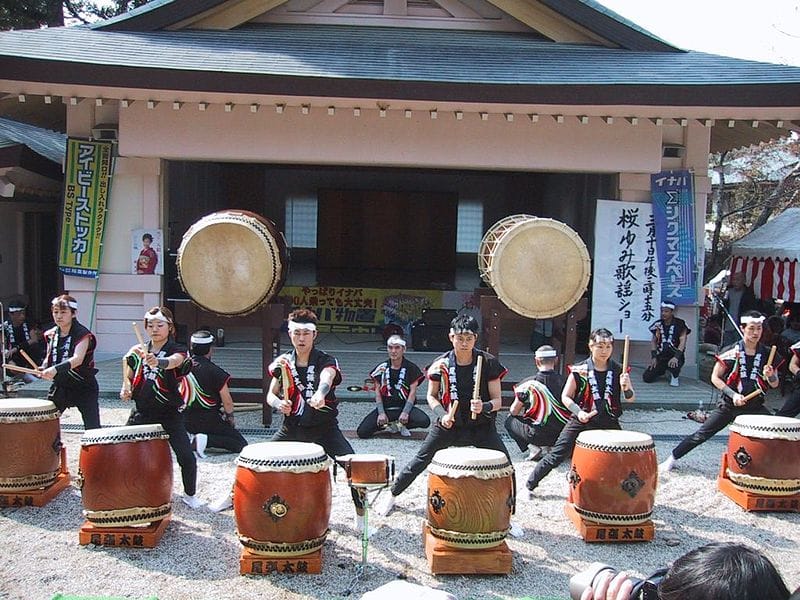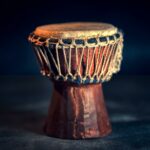Picture this: a thunderous beat that resonates through time and space, a sound that has captivated hearts for centuries. This is the magic of Japanese taiko drums. These powerful instruments have been with us since ages past, used in everything from ancient rituals to thrilling modern performances. Join us on a journey through the captivating history of taiko drums, a testament to their enduring charm and cultural significance.
History of Taiko Drums
Taiko drums, those large and captivating instruments, have been an integral part of Japanese culture for centuries, and their story is as fascinating as their sound. Their presence in Japan dates back to the 6th century CE, with evidence suggesting they likely arrived from mainland Asia. In those early centuries, taiko drums served not only as musical instruments but also as vital communication tools.
Imagine a time before modern technology, where the booming resonance of these drums echoed across vast distances, carrying messages of warning, calls to action, and even rallying cries on battlefields. Beyond their practical applications, taiko drums were deeply intertwined with spirituality, playing a significant role in religious ceremonies and festivals. Their powerful rhythms were believed to forge connections with the divine, a belief that still resonates in contemporary Japanese culture.
For centuries, taiko drumming was primarily a solo art form. However, the mid-20th century witnessed a revolutionary shift with the emergence of “kumi-daiko,” a dynamic and energetic style of ensemble drumming. Visionaries like Daihachi Oguchi spearheaded this transformation, introducing the concept of group performances that amplified the visual and auditory impact of taiko. Groups like Ondekoza and Kodo emerged as pioneers of this new style, captivating audiences worldwide with their precision, athleticism, and the raw power of synchronized drumming.
Today, taiko drumming has transcended its traditional roots to become a vibrant and evolving expression of Japanese culture. It finds its place in diverse settings, from community festivals and theatrical productions to social activism and even fusion music collaborations. The allure of taiko has broken geographical boundaries, captivating audiences globally and inspiring countless individuals to pick up the “bachi” (drumsticks) and experience the magic firsthand.
Researchers and historians continue to delve into the depths of taiko drumming, exploring its origins and tracing its evolution through the centuries. With each new discovery, the story of these seemingly simple yet profoundly impactful instruments grows richer and more captivating.
Key Points on the History of Taiko Drums:
- Appeared in Japan in the 6th century, likely originating from mainland Asia.
- Initially used as tools for communication, warning, and military rallying.
- Deeply connected to spirituality, played in religious ceremonies and festivals.
- Solo drumming transitioned to group performances in the mid-20th century, known as “kumi-daiko.”
- Ensembles such as Ondekoza and Kodo popularized kumi-daiko internationally.
- Taiko drumming has evolved into a vibrant and diverse art form, used in various settings today.
- Ongoing research continues to uncover the origins and development of taiko drums throughout history.
What do taiko drums symbolize?
Taiko drums are more than just instruments; they are deeply entwined with the cultural identity of Japan, much like the bald eagle symbolizes the United States. The deep, resonant booms of the taiko evoke a sense of unity and national pride, stirring the hearts of those who hear them.
But the symbolism runs deeper than national identity. The drums are believed to possess a spiritual energy, a power capable of reaching the heavens. This spiritual aspect is evident in their continued use in ceremonies and rituals, where their rhythms are thought to cleanse sacred spaces and establish connections with the divine.
The movements of taiko drummers are also highly symbolic. The energy and precision poured into each strike resemble a carefully choreographed dance, reflecting the dedication and skill required to master this ancient art form. Each beat carries the weight of tradition, passed down through generations, ensuring the legacy of taiko continues to resonate.
While the full extent of the taiko drum’s symbolism may remain a mystery, shrouded in the depths of cultural understanding, one thing remains clear: taiko drums are not merely instruments but vessels of Japan’s soul, its energy, and its enduring spirit.
Key Insights on the Symbolism of Taiko Drums:
- Cultural Pride and Unity: Taiko drums embody cultural pride and unity, representing the spirit of the Japanese people. They are played in various settings, from traditional religious ceremonies to modern concerts and educational programs.
- Spiritual and Communal Traditions: Taiko drums have a profound connection to Japan’s spiritual and communal traditions. Rooted in ancient Shinto rituals, they were believed to possess the power to communicate with deities and purify sacred spaces.
- Rhythm of Japanese Percussion: Taiko drums symbolize the powerful, rhythmic, and dynamic energy of Japanese percussion. Their distinctive sound is a testament to the skill and passion of the Japanese drummers who play them.
- Evolution and Legacy: Taiko drums have a rich history that spans centuries. They have evolved over time, adapting to modern tastes while retaining their cultural significance.
What are some interesting facts about taiko drumming?
While the captivating sounds and visual spectacle of taiko drumming are fascinating in themselves, the history and cultural significance surrounding these instruments add another layer of intrigue.
- Ancient Origins: While deeply ingrained in Japanese culture, taiko drumming likely originated from ancient Korea and China, dating back to the 6th century CE. These booming rhythms have been echoing through time for over 1,400 years!
- Multifaceted Tools: Taiko drums were not merely instruments for music but served a variety of purposes in ancient Japan. From adding an air of drama to religious ceremonies to igniting the spirits of warriors on the battlefield, these drums were woven into the very fabric of everyday life.
- Artisan Craftsmanship: The creation of a taiko drum is an art form in itself, passed down through generations of skilled artisans. Each drum is meticulously handcrafted, with expert woodworkers shaping the body, leatherworkers preparing the animal skin for the drumhead, and tuners painstakingly refining the sound to achieve the perfect resonance.
- Global Phenomenon: Taiko drumming has transcended its geographical boundaries to become a global phenomenon. Groups like Ondekoza and Kodo have enthralled international audiences with their electrifying performances, showcasing the power and beauty of taiko on the world stage. Their performances are not just musical concerts but spectacles of energy, rhythm, and athleticism.
- Unifying Force: Perhaps one of the most remarkable aspects of taiko drumming is its ability to bring people together. The rhythm of the taiko transcends language and cultural barriers, creating a shared experience that resonates with people from all walks of life. It’s no wonder that UNESCO recognizes taiko drumming as an Intangible Cultural Heritage of Humanity.
Here’s some more food for thought:
- Collaborative Spirit: Taiko drumming is inherently collaborative, requiring a group of drummers working in perfect synchronization to create its intricate rhythms.
- Therapeutic Benefits: Some believe that taiko drumming offers therapeutic benefits, providing stress relief, improving coordination, and offering an outlet for emotional release.
- Living Heritage: For many Japanese people, taiko drumming serves as a vibrant link to their heritage, fostering a sense of belonging and cultural identity. It’s a living, breathing reminder of their ancestral traditions.
What does taiko mean in Japanese?
While the word “taiko” has become synonymous with a specific type of Japanese drum, particularly within the context of those high-energy performances, its meaning in Japanese is broader than that. In its simplest form, “taiko” translates to “large drum.”
However, the word often evokes imagery of the “wadaiko,” a specific type of large Japanese drum commonly used in those captivating performances. These drums can be massive, requiring multiple people to play and producing a sound that reverberates through your very core.
The history of these drums dates back centuries, likely arriving from mainland Asia and serving various purposes beyond music. Imagine the booming sound of the taiko echoing across ancient battlefields, directing troops and striking fear into the hearts of enemies.
Over time, the musical potential of these drums was realized, and they gradually became incorporated into religious ceremonies, theatrical performances, and festivals, weaving themselves into the cultural tapestry of Japan.
Today, the cultural significance of taiko drumming remains strong, captivating audiences worldwide and continuing to inspire awe and wonder. From traditional ceremonies in the heart of Japan to modern concert halls in bustling cities, the sound of the taiko continues to resonate, a testament to its enduring power.
Here’s a little cheat sheet to remember:
| Term | Meaning |
|---|---|
| Taiko | Large drum (general term) |
| Wadaiko | Specific type of Japanese performance drum |
| Kumi-daiko | Ensemble of taiko drums |
So, the next time you encounter the word “taiko,” remember that it represents more than just a drum; it embodies Japanese culture, history, and the enduring power of artistic expression.
What is the difference between daiko and taiko?
While both “daiko” and “taiko” refer to drums within the context of Japanese percussion, there’s a subtle yet significant distinction between the two. Think of “taiko” as the broader term, encompassing the entire world of Japanese drums, their history, traditions, and cultural significance. “Daiko,” on the other hand, acts more like a descriptive tag, often specifying a particular type of drum, a group of drummers, or even a specific style of playing.
“Taiko” represents the umbrella term for all Japanese drums, including those massive “wadaiko” seen in grand performances and the exhilarating ensemble style known as “kumi-daiko.” It encompasses the historical weight, the cultural traditions, and the very soul of Japanese percussion.
“Daiko” comes into play as a more specific term. While it can simply mean “drum” in Japanese, it’s frequently paired with other words to provide context or specificity. For instance, “Osuwa-daiko” and “Za Ondekoza” are names of renowned taiko drumming groups that have captivated global audiences with their powerful rhythms. When you encounter “daiko” attached to a word, it usually signifies a particular type of drum, a specific group of drummers, or a unique style of playing.
To simplify:
- Taiko: The overarching term for Japanese drums, encompassing their history, tradition, and artistic essence.
- Daiko: A more specific term used to specify a type of drum, a group of drummers, or a particular style of playing.
Both “taiko” and “daiko” represent the vibrancy and excitement of Japanese drumming, each contributing its unique flavor to this rich and multifaceted art form.
What are the four principles of taiko drumming?
Beyond the thunderous rhythms and captivating performances lies a set of guiding principles that underpin the art of taiko drumming. These principles, while not rigid rules, serve as guiding lights for taiko players, helping them connect with the spirit of this ancient practice and achieve a deeper understanding of its essence.
1. Attitude: Attitude sets the stage for a powerful and meaningful taiko performance. It encompasses respect for the tradition, for fellow drummers, and even for the drums themselves. This reverence translates into discipline, dedication to honing one’s skills, and a deep appreciation for the art form’s history and cultural significance.
2. Kata: Kata focuses on the visual representation of taiko drumming. Imagine a meticulously choreographed dance, but with drums! It encompasses the drummer’s posture, movements, and how these physical expressions complement and enhance the music. Kata transforms sound into a captivating visual experience.
3. Musical Technique: This principle delves into the heart of taiko drumming—mastering the art of striking the drum. It encompasses the use of different sticks, striking techniques, and rhythmic variations to create diverse sounds and dynamic rhythms. Musical technique seeks the perfect harmony between movement and sound, crafting a truly unforgettable auditory experience.
4. Ki: The most elusive of the four principles, “Ki” refers to the energy or spirit infused into taiko drumming. It’s the invisible force that flows between the drummers, the drums, and even the audience, creating a palpable connection. Ki is the soul of taiko, leaving a lasting impression long after the final beat fades away.
These four principles—Attitude, Kata, Musical Technique, and Ki—work in concert, like pieces of a puzzle, to create the magic that is taiko drumming. They serve as a reminder that taiko is more than just striking drums; it’s an art form rich in history, imbued with deep meaning, and possessing the power to move us in profound ways.
Why do Taiko Drummers Yell?
Those who have witnessed the power of a taiko drumming performance have likely noticed the drummers’ emphatic shouts punctuating the rhythmic beats. These shouts, known as “kakegoe” in Japanese, are not merely random expressions but purposeful vocalizations that add layers of drama and intensity to the performance.
Think of it this way: an action movie without sound effects would lack a certain visceral impact. Similarly, kakegoe in taiko drumming acts as a sonic exclamation point, allowing the drummers to channel their energy and passion into the performance, enhancing the overall emotional experience.
These shouts are reminiscent of the “kiai” in martial arts—sharp, forceful vocalizations used to focus energy and even intimidate opponents. Some scholars believe that kakegoe may have roots in ancient Japanese martial arts traditions, where such vocalizations played a significant role.
Beyond their energizing effect, kakegoe also fosters a sense of unity among the drummers. The synchronized shouts act as a shared breath, uniting them in their movements and creating a palpable sense of shared energy that radiates outward to the audience.
Interestingly, the origins and purpose of kakegoe are still not fully understood. Some researchers suggest connections to ancient rituals or work songs, but further research is needed to unravel the full scope of their historical development.
So, the next time you find yourself captivated by the thunderous spectacle of taiko drumming, pay attention to those powerful shouts. They’re not merely for show but an integral part of this captivating art form, adding depth, energy, and a touch of mystery to the performance.
What is the purpose of the taiko in Japanese culture?
The taiko drum, in its various forms, occupies a space in Japanese culture that extends far beyond its function as a musical instrument. It’s a multifaceted symbol, representing a rich tapestry of history, spirituality, and communal expression.
Think of the taiko as a versatile tool, adaptable to a variety of contexts and purposes. From the massive drums capable of shaking the ground beneath your feet to the smaller, more nuanced instruments that add subtle layers of sound, the taiko family serves a diverse range of roles.
- Religious Significance: The use of taiko drums in Shinto and Buddhist ceremonies dates back centuries. Imagine the rhythmic pounding echoing through a serene temple, accompanying ancient chants and prayers. These powerful beats were, and in many ways still are, believed to bridge the gap between the physical and spiritual realms, facilitating communication with deities.
- Theatrical Enhancement: Taiko drums also play a crucial role in traditional Japanese theater, such as Noh and Kabuki. They provide the heartbeat for epic tales and emotional narratives, adding a visceral layer of intensity and drama to the performances.
- Festive Celebrations: Japanese festivals are renowned for their vibrant energy, colorful spectacles, and, of course, the infectious rhythms of taiko drums. Amidst the parades, dances, and communal celebrations, taiko drumming sets the pace, bringing people together to share in the joy of tradition and cultural heritage.
- Modern Evolution: In recent years, taiko drumming has experienced a resurgence in popularity, embraced by contemporary musicians and artists who incorporate its powerful rhythms into their work, bridging the gap between tradition and innovation.
The taiko drum’s enduring significance in Japanese culture can be summarized in these key takeaways:
- More Than Music: It represents Japan’s rich cultural heritage, intricately woven into religion, art, and everyday life.
- Unifying Force: Whether through communal drumming or the shared experience of a performance, taiko possesses the power to connect individuals and foster a sense of shared identity.
- Ever-Evolving: The story of taiko is far from over. As new generations continue to explore its potential, the future promises exciting rhythms and innovative expressions of this ancient art form.
This exploration merely scratches the surface of the vast world of taiko drumming. From intricate playing techniques to regional variations and the personal stories of the drummers themselves, there’s a wealth of knowledge waiting to be uncovered. So, if curiosity strikes, do not hesitate to delve deeper into the captivating world of taiko.
Is Taiko Drumming Religious?
The question of whether taiko drumming is inherently religious is not easily answered with a simple yes or no. The relationship between taiko and religion is complex, rooted in centuries of tradition while simultaneously evolving alongside modern interpretations.
The presence of taiko drums in Shinto shrines and Buddhist temples speaks volumes about their historical and spiritual significance. The deep, resonant beats echoing through these sacred spaces were, and in many cases, still are, intended to facilitate connection with the spiritual realm. The drums act as a conduit, bridging the gap between the mundane and the divine.
For centuries, these rhythms have been integral to religious ceremonies, calling upon deities and creating an atmosphere of reverence and spiritual connection. Festivals, too, feature taiko drumming prominently, from the joyous celebrations of Obon, welcoming ancestral spirits, to the more solemn observations of Bon Odori, where the drums guide departed souls on their journey.
Beyond organized religion, taiko drumming also has roots in shamanistic practices. Shamans, often referred to as “yamabushi,” utilized the drums’ energy to enter trance-like states, seeking wisdom and guidance from the spirit world.
While taiko drumming’s historical and spiritual roots run deep, it’s essential to recognize its evolution in modern times. Today, taiko performances grace diverse settings, from grand concert halls to community centers. This shift in context does not necessarily diminish its spiritual aspect but rather highlights the multifaceted nature of its interpretation and experience.
Consider this analogy: a beautifully crafted bowl can serve as a sacred object in religious rituals or as a cherished piece of tableware in a family home. The bowl itself remains unchanged, but its meaning and purpose are fluid, shaped by time, place, and the individuals interacting with it.
Points to Ponder:
- The fact that taiko drumming, with its possible origins in China, Korea, or even India, found such profound meaning within Japanese culture is a testament to its adaptability and enduring appeal.
- The concept of rhythm and sound as a bridge to the divine is not unique to Japan and can be found in various cultures throughout history.
- The ways in which ancient traditions like taiko drumming are reinterpreted and kept alive by new generations offer a fascinating glimpse into the ever-evolving nature of culture.
The world of taiko is vast and full of fascinating nuances. Keep listening, keep learning, and you might just feel that spiritual connection for yourself.
What does the Tomoe symbolize?
The Tomoe, a symbol characterized by its swirling comma-like shapes, holds deep significance in Japanese culture. It’s a visual representation of complex concepts like unity, the flow of life, and inherent spiritual energy.
One of the most common representations of the Tomoe features three swirls, known as the Mitsudomoe. Each swirl is believed to represent a different aspect of the universe—heaven, earth, and humanity—coming together in perfect harmony. It’s a powerful reminder of the interconnectedness of all things.
However, the Tomoe is not solely about balance and tranquility; it also embodies movement and energy. Those swirling shapes are not static but rather suggest a continuous flow, a visual representation of the cyclical nature of life, change, and interconnectedness. This association with dynamic energy is particularly evident in its connection to Hachiman, the Shinto deity of war and archery.
The Tomoe frequently adorns Shinto shrines, where it’s believed to possess spiritual power, acting as a talisman to ward off negative energy and attract good fortune. Some even believe it can enhance one’s spiritual awareness and facilitate connection with the divine.
The origins of the Tomoe are shrouded in mystery, but a few compelling theories offer possible explanations:
- Chinese Influence: One theory suggests it evolved from the Chinese character “巴,” which resembles a person lying on their stomach.
- Archery Connection: Another theory links the Tomoe to ancient archery, proposing that it might have been a decorative element on archers’ arm guards.
Interestingly, symbols resembling the Tomoe appear in cultures worldwide, suggesting that the concepts it represents—unity, energy, and interconnectedness—resonate universally. The Chinese Yin-Yang symbol, with its black and white swirls signifying balance, shares a visual similarity, as do ancient Celtic designs and even some Korean motifs.
The Tomoe’s appearance across cultures and throughout history highlights its enduring relevance and the universality of its symbolism. It’s a timeless reminder of the interconnectedness of all things, the dynamism of life, and the enduring power of symbolic representation.
What is the myth of the taiko?
The taiko drum, steeped in history and cultural significance, also carries its own captivating origin myth. This tale, passed down through generations, adds a touch of magic and mystique to these already impressive instruments.
The myth, as recounted in the ancient Japanese chronicle Nihon Shoki, tells the story of the sun goddess Amaterasu, who retreated into a cave, plunging the world into darkness. Only the goddess Ame-no-Uzume possessed the wit and charm to lure her out. And how did she achieve this feat? Through the irresistible rhythm of the taiko, of course!
Ame-no-Uzume’s drumming and dancing were so full of life and joy that Amaterasu couldn’t resist peeking out from her hiding place. The compelling beat drew her out, bit by bit, until the world was bathed in sunlight once more.
This myth highlights the profound connection between the taiko and spiritual power within Japanese culture. It suggests that these drums possess an inherent magic, a link to the divine that has resonated through centuries of religious ceremonies, cultural celebrations, and artistic expressions.
While the exact timeline of the taiko’s arrival in Japan remains uncertain, some experts believe it emerged around the 6th century CE. Evidence suggests influences from other Asian countries, including China, Korea, and possibly even India, highlighting the interconnectedness of cultures even in ancient times.
The myth of the taiko is more than just an ancient story; it’s a testament to the enduring power of these instruments and their significance within Japanese culture. Every time a taiko player strikes the drumhead, they tap into that ancient energy, that bridge between the physical and spiritual, reminding us of the enduring power of music, myth, and cultural heritage.
- Sept 31 Myth: Unveiling Calendar Secrets - March 18, 2025
- How Long & Till December 18, 2025: Accurate Countdown Guide - March 18, 2025
- Discover Japanese Artists: A Complete History - March 18, 2025
















